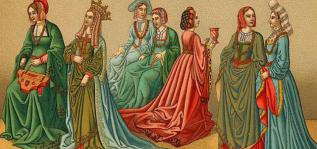The Renaissance
The European
renaissance began in Florence in the 14th century. The term
renaissance is derived from the French word meaning rebirth. This period in Europe was considered as the
bridge between the middle ages and the modern history. It was during this
period that European history experienced many changes. It was the phase of Europe between the 14th
and the 16th centuries that revived the classical art and the
intellect of the Ancient Greece and Rome.
The
renaissance period, as seen by many as the social and political upheaval, was also
the time of the development of the art and science, literature, architecture
and philosophy. It was in these disciplines, the emergence of new trends and
fresh styles, which were inspired by the ancient European history.


Renaissance
period was also a turning point in people’s attitude towards their clothing and
appearances. It was the time when the idea of fashionable dressing came into focus.
Tailoring was transformed and innovative techniques in cutting and sewing came
up. Use of accessories like hats, gloves, bags and hairpieces came into
fashion.
During the
renaissance the type of clothing varied according to the social class that person
belonged to. During this period clothing was all about showing of one’s social
standing in the society. The clothing in this period was a great symbol of
one’s wealth, and there were several differences in the clothes that a high
class person is wearing than to what a peasant would wear.
The clothing
of the wealthy was made of expensive fabrics like silk, velvet, fur, brocade
and cotton. Fur was often used as lining inside of the garments. Their clothing
was made of darker colors and elaborate embroidery and jewels were often sewn
into the garments.
In contrast
to the wealthy, the lower classes wore much simpler garments. There were also
rules that restricted lower classes to clothing of only one color. Many of the
clothing styles of the lower classes were imitates of the clothing of the
wealthy.
The women’s
clothing during this period was very extravagant and multi layered. Women would
wear full length gowns with tight fitted bodice with many layers in the garment
and usually had sleeves. Women of lower classes had fewer layers in their
clothing than compared to that of wealthy women. The layers of a women’s gown
was also considered as a status symbol. The more layers you wore, the wealthier
you are. Dresses with elaborate necklines were also fashionable.
Women of
lower class wore fewer layers and less restrictive styles as it gave more
freedom of movement, they also wore much looser corsets or none at all. All
women wore linen chemises or shifts, petticoats to fill out the gown and
stockings which were normally knee high.

Headwear was
also very popular for women during the renaissance. There were many different
styles of headdresses like the “Pointed Cone”, the French hood style and lace
trimmed veils were also very common. Some headwear completely concealed the
hair of the women while others allowed the hair to be shown.
Men’s
clothing during the renaissance changed a few times but the most popular style
was the “square” silhouette during the reign of Henry VIII. The “square”
silhouette was achieved by the widening of the shoulders on vests and coats and
padding them which was often made of horsehair. They used to wear knee length
breeches with hose or stockings instead of trousers. The shirts were with lace
collars and cuffs with low neckline. Over the shirt would go a fitted top
called doublet and a close fitting jacket called the jerkin.
Men’s
headwear included a wide brimmed hat to finish off the square look.



































